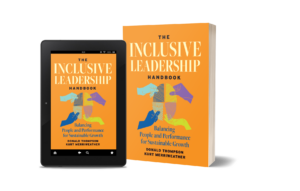Being a marketing leader has never been more challenging. Teams are being flooded with data and new technologies like AI are being met with fear and excitement. Prospects and customers are being inundated with hundreds of marketing messages daily, yet few make any impact. Chief Marketing Officers (CMOs) are being asked to build teams that include marketing communications professionals along with data scientists, data engineers, and user experience experts. And, these team members expect to have flexibility around when and where they work.
Marketing leaders who rise to these challenges are the strategists and business operators who can configure their teams to understand their customers while fostering collaborations that deliver results. Enter a new type of role—the inclusive marketing leader.
Inclusive leaders assemble and sustain high-performing teams that create powerful messages that connect with target audiences while generating demand. Effective leaders value the presence and participation of a diverse creative team to understand multiple customer segments. For example, a creative team with a member who shares a customer’s ethnicity is 152% more likely than another team to understand that customer’s needs.
Inclusive leaders hire for culture add, rather than culture fit, and they are savvy enough to recognize when they need additional guidance. When inclusive marketers lack information about specific target audiences, they work with partners outside their organization to craft messages that are appropriate and authentic.
The creation of powerful marketing campaigns requires an innovation culture that balances marketing insights with teamwork. Culture is the biggest driver of employee engagement and worker productivity, and by definition, inclusive leaders establish healthy, trust-based workplace cultures to foster creativity. High-performing teams, guided by inclusive leaders, elevate diverse perspectives, which drive innovation, efficiency, and quicker, better decision-making.
“Being an inclusive leader isn’t just about your personal journey; it’s about fostering an environment where everyone’s experiences are valued,” says Edessa Polzin, the Manager of Learning Partnerships at the American Marketing Association (AMA).

Here are six tips to become an inclusive marketing leader who builds high-performing teams.
1) Connecting With Teams Through Authentic Communication
Drawing from their communication skills in reaching prospects and customers, inclusive marketing leaders build internal support for new initiatives and craft compelling narratives that drive customers to act. This requires selling ideas within the marketing team as well as creating messages that reach customers. However, communication involves more than creating a persuasive message. True communication is a two-way exchange, one that requires deep listening and a willingness to mindfully and respectfully connect with another person.
Inclusive leaders approach interactions with empathy. They use inclusive language to demonstrate their respect and care for other people, and they listen to other perspectives before launching campaigns.
On the advice of two women bloggers, fans of Stanley’s Adventure Quencher Travel Tumbler, the 110-year-old brand expanded its target audience and increased its annual revenues from $75 million to $750 million. Long popular among outdoor workers and adventurers, Stanley partnered with online influencers and is now a favorite with women who collect its colorful reusable travel mugs.
2) Gathering Multiple Viewpoints and Perspectives
The creative process that leads to great marketing concepts hinges on synthesizing information and enabling the free-flowing exchange of ideas. From agencies partnering with clients to in-house professionals building an internal brand, marketers have to collaborate to generate persuasive messages that resonate with audiences.
“Inclusive leadership means being open to many different perspectives and knowing that it’s not just about how I believe something should be thought of or done, even with the best of intentions. It means thinking about how others feel,” says Abha Bowers, Chief Growth Officer at Walk West, a marketing and branding agency.
Within their own teams, leaders can use questions to solicit a wide range of opinions and perspectives. Questions can also be used to identify the target customer more clearly, highlight assumptions when creating messaging, and reveal knowledge gaps that can lead to missteps. Not only does involving all team members in the decision-making process lead to more effective outcomes, but it also fosters a greater sense of camaraderie and shared purpose.
3) Understanding and Bridging Cultural Gaps
Cultural intelligence enables marketing leaders to bridge cultural gaps and expand demand by authentically targeting new audiences. Savvy marketers are keenly aware of changing demographics and the reverberations of an increasingly diverse society. By understanding everyone’s individual worldview, marketing leaders can effectively navigate the complexities of a global business landscape needed to uncover new opportunities.
Lenovo is a global technology company specializing in designing, manufacturing, and marketing consumer electronics, personal computers, software, business solutions, and related services. Calvin J. Crosslin, Vice President/Chief Diversity Officer at Lenovo and President of the Lenovo Foundation, says cultural intelligence is the key to creating relationships needed to foster powerful collaboration.
“By working to create a culture where your team acknowledges cultural differences, you can help your team forge meaningful relationships with colleagues and associates—no matter where they are from,” Crosslin explains.

4) Mastering Self-Awareness to Increase Capability
Experience can make senior leaders less apt to question their assumptions and entertain conflicting points of view. However, by mastering self-awareness, understanding their unconscious bias, and listening to multiple viewpoints, leaders make decisions more quickly with better outcomes. In fact, self-awareness was the strongest predictor of overall success for leaders, accounting for 30% of the variation in leadership effectiveness.
To amplify performance and innovation, inclusive leaders strive to create psychological safety within their teams. Creativity in particular blossoms when marketing teams feel empowered to explore new ways of thinking. When creating marketing campaigns, it is important to ask why a campaign might not work and what assumptions are being made about an audience. This helps to guard against bias while creating an environment to come up with new solutions that may have been discounted.
“Inclusive leadership involves admitting mistakes, taking responsibility, and ensuring everyone feels safe enough to push forward and innovate by questioning assumptions. Inclusion should result in safety, and safety should result in growth—in all its forms,” says Bob Osmond, president of Racepoint Global, an integrated public relations and communications firm.
5) Approaching New Markets with a Growth Mindset
Creativity and an openness to new ideas also feed the growth mindset that every inclusive leader needs to flourish and achieve long-term success. Leaders who insist on ongoing improvement set the stage for greater innovation, proficiency, and higher productivity. Inclusive leaders work to learn about things they don’t know and are voracious in pursuit of good information.
Marketing professionals who can leverage a growth mindset along with cultural intelligence give their organizations a competitive advantage. By amplifying the viewpoints of underrepresented groups and listening to customers who aren’t being served by existing products and services, companies can tap into new business opportunities. The result is more inclusive products and marketing strategies. For example, serial innovator Rihanna has built Fenty Beauty and SavageX Fenty by offering cosmetics for a wider variety of skin tones and lingerie for a wider variety of body shapes and genders.
6) Fostering Brand Loyalty and Long-term Relationships
Marketers strive to create strong, trusted brands that inspire long-term loyalty. Every campaign is an opportunity to strengthen relationships with clients and consumers. Inclusive leaders have a similar outlook, one that values reliability, relationship-building, and high standards.
“As a leader, you have to show up and put in a hard day’s work just as you ask your team to do. You also have to be there to support them—to help them succeed and grow,” says Donald Thompson, CEO and Co-founder of The Diversity Movement.
A people-first orientation is woven throughout inclusive leadership and the seven core competencies of inclusive leaders–communication, collaboration, cultural intelligence, self-awareness, capability, growth mindset, and reliability. By adopting these inclusive practices, marketing professionals can enhance their personal expertise, build stronger teams, and create a workplace culture where every employee can contribute their best work.
 For more on inclusive leadership and how it drives employee engagement in any industry, look for The Diversity Movement’s new book, The Inclusive Leadership Handbook: Balancing People and Performance for Sustainable Growth, by Kurt Merriweather, VP of Marketing, and Donald Thompson, CEO. TDM has also created LeaderView, a leadership assessment tool that uses cultural competency as a driver for improving whole team performance.
For more on inclusive leadership and how it drives employee engagement in any industry, look for The Diversity Movement’s new book, The Inclusive Leadership Handbook: Balancing People and Performance for Sustainable Growth, by Kurt Merriweather, VP of Marketing, and Donald Thompson, CEO. TDM has also created LeaderView, a leadership assessment tool that uses cultural competency as a driver for improving whole team performance.
Kurt Merriweather, CDE, is an accomplished product strategist and marketing executive. He is co-founder and Vice President of Marketing at The Diversity Movement. Connect with him on Linkedin.




